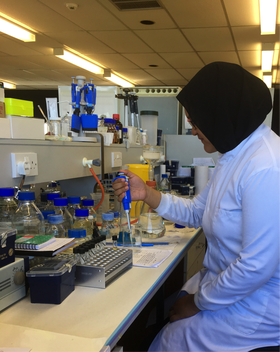Spotlight on Grants: Nickel and cobalt in Streptococcus
Posted on October 20, 2016 by Siti Nur Amalina & Dr Nick Jakubovics
Each year, the Microbiology Society awards a number of grants that enable undergraduates to work on microbiological research projects during the summer vacation. Over the next few weeks, we’ll be posting a series of articles from students who were awarded Harry Smith Vacation Studentships this summer. This week is Siti Nur Amalina, a third-year student studying Biomedical Science with Medical Microbiology at Newcastle University.
Nickel and cobalt in oral bacteria S. sanguinis and S. gordonii
FROM THE STUDENT: Siti Nur Amalina

My summer project focused on two bacterial species that live in the mouth, Streptococcus sanguinis and S. gordonii. These Gram-positive bacteria are most abundantly found in dental plaque, which is actually a community of microbes living in a biofilm on top of the enamel.
Although they are considered to be ‘commensals’, meaning they live in the oral cavity without harming/affecting the host, these species are thought to contribute to the accumulation of dental plaque and to the recruitment of pathogens, causing diseases such as dental caries and periodontitis.
This summer research project was initiated because, recently, work in the host laboratory discovered that all S. sanguinis strains contain a 70-gene cluster that is absent from S. gordonii. This cluster encodes nickel and cobalt uptake systems, as well as pathways that enable the microbes to utilise certain organic molecules. This has led to a hypothesis that these genes are important in determining the different ecological roles of S. sanguinis and S. gordonii.
The aim of my project was to try to investigate whether the two species require cobalt for growth, how much cobalt they store inside their cells, and how cobalt allows them to use different compounds for growth.
In the Oral Microbiology laboratory in Newcastle University, I was under the supervision of Dr Nicholas Jakubovics, who works closely with oral streptococci and bacterial biofilms. During the eight weeks of this summer studentship, I completed a series of different experiments with the help of others in the research group. Familiarising myself to a new laboratory environment was kind of awkward at first but everyone was really accommodating and I quickly gained confidence within a couple of weeks working in the lab. I got to learn new things daily and had first-hand experience on everything. As I was involved in planning and organising the experimental work, this made me more proactive. I could give opinions and receive feedback from the other lab members about my work.
One of the most interesting experiences was working with inductively coupled plasma mass spectrometry (ICP-MS) with Dr Emma Tarrant and Dr Kevin Waldron. We used this instrument to measure the concentration of intracellular cobalt in S. sanguinis and S. gordonii when grown in different environments. As an undergraduate student, we rarely handle advanced laboratory equipment due to the high number of students on the course and the limited tools available. Therefore, it was definitely an unforgettable experience and I believe it will be useful knowledge for me to bring into my final year.
In my opinion, summer studentships like this are extremely beneficial, as I have gained an immeasurable amount of knowledge and skills just from this short experience. During the timespan of working in the laboratory, I also got to personally observe how researchers, postgraduates and lab technicians work. It definitely has made me think more about my future plans and provided insights into what research careers looks like. So far, this research experience has been very positive for me and I am thankful to receive support from the Microbiology Society through the Harry Smith Vacation Studentship.
FROM THE SUPERVISOR: Dr Nick Jakubovics
It has been a real pleasure to host Siti in the laboratory over the summer. Her project has provided an opportunity for us to start to explore an interesting topic that has developed from some genomic sequencing that I have done recently with collaborators at the University of Malaya in Kuala Lumpur. Coincidentally, Siti is also Malaysian so she has continued the project’s connection with Malaysia.
The goal of our work has been to understand the key differences between two closely related oral streptococci, S. sanguinis and S. gordonii. Although both species are commonly found in dental plaque, S. sanguinis is almost always present in higher numbers. It is not clear how S. sanguinis manages to outgrow S. gordonii in dental plaque and in fact previous work has shown that S. gordonii can outcompete S. sanguinis for adhesion to saliva pellicle (a protein film that forms on enamel).
Understanding why species such as S. sanguinis are such effective colonisers may potentially lead to new approaches to restrict dental plaque growth and help people maintain good oral hygiene. This project is providing the preliminary data that will hopefully start a new area of research for an enthusiastic student like Siti to explore in more detail, perhaps as a larger postgraduate research project.
To find out more about the Harry Smith Vacation Studentships, please contact [email protected]
